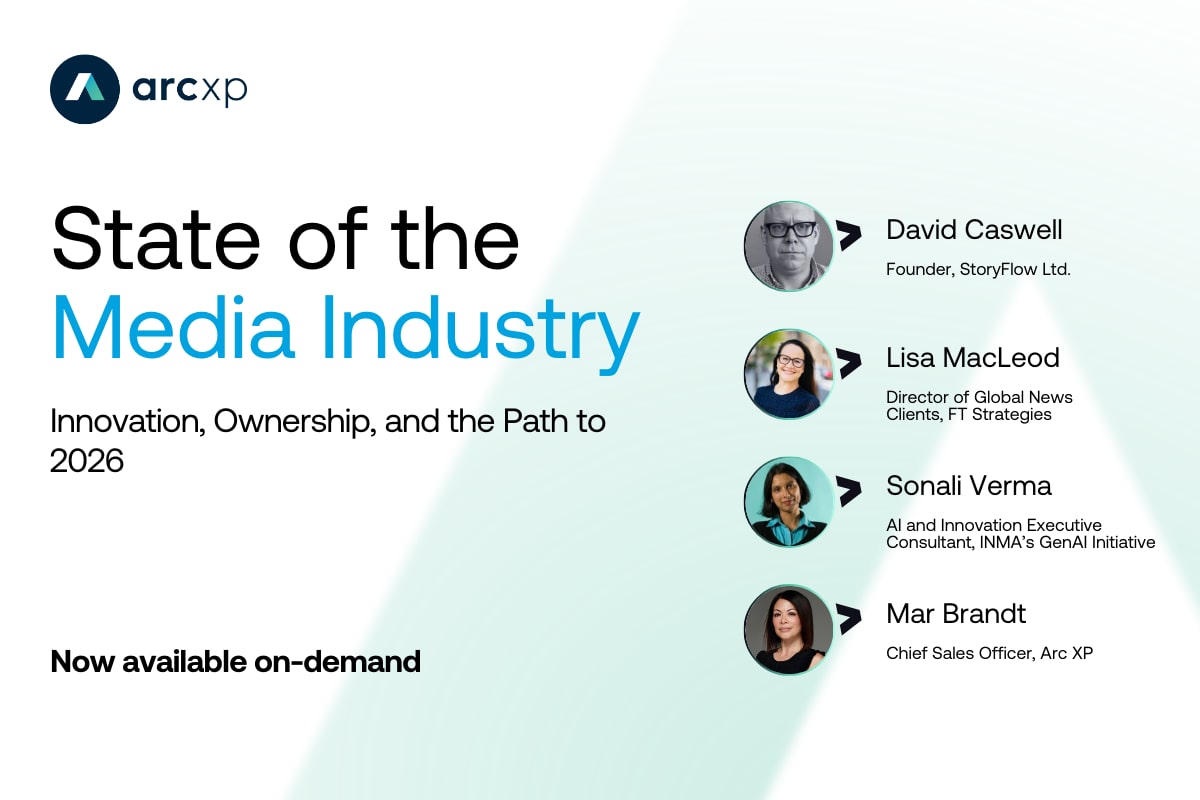Essential AI Capabilities for the Modern Newsroom

Artificial intelligence (AI) isn’t just a future promise—it’s already revolutionizing how content is created, managed, and consumed. In record time, AI has become the fastest-growing technology, with platforms like ChatGPT amassing more than 80 million users within a year and a half, underscoring its pivotal role in modern communication and innovation.
For media companies navigating a digital-first era, the shift towards an AI-first mentality presents a unique opportunity to lead as early adopters. Embracing AI now positions publishers and broadcasters to transform traditional business models and drive industry innovation.
Ethically enhancing content management with AI
Digital innovation waits for no one. Media companies must act decisively to integrate AI into their content strategies to stay ahead. Early adopters are already reaping the rewards: streamlined workflows and higher content quality are just the beginning.
AI enhances, not replaces, human creativity. By embedding AI within content management systems (CMS) and broader tech ecosystems, media organizations can boost operational efficiency, elevate content quality, and enhance audience engagement—without compromising ethics or transparency. The key is integrating generative AI solutions directly into CMS platforms, ensuring seamless and secure integration that harnesses AI’s transformative potential responsibly while keeping journalists in control.
Key AI capabilities for media
When evaluating AI solutions, focus on capabilities that optimize efficiency and empower creativity:
- Story Summarization: AI tools can distill lengthy articles into concise summaries, providing readers with quick insights. This feature saves time for both creators and consumers while enhancing user experience.
- Recommend Tags: Large language models (LLMs) suggest relevant tags or keywords, optimizing search engine visibility and ensuring consistent categorization within the CMS. Automated tagging enhances content organization and discoverability.
- Generate Headlines: AI-driven tools use natural language processing to craft compelling headlines that attract audience attention and boost engagement. These tools help create impactful headlines that resonate with the target audience.
- Generate Key Takeaways: AI tools extract essential information from articles, offering readers a quick overview before diving into the details. This improves article readability and comprehension.
- Open Prompt: AI-powered assistants within the CMS facilitate tasks such as grammar checks, spell checks, and content refinement through interactive prompts, enhancing productivity and collaboration between human editors and AI tools.
- Translations: AI-driven translation capabilities streamline content localization, translating content into multiple languages quickly and accurately. This feature enables media organizations to expand their global reach and cater to diverse audiences without sacrificing quality.
Integrating these AI capabilities into workflows empowers newsrooms to enhance efficiency, improve content quality, and deliver more compelling experiences to their audiences.
Customizing AI for editorial excellence
Customization is crucial for effective AI integration into editorial workflows. Media organizations can tailor AI models and prompts to align with editorial guidelines, ensuring consistency and quality across content.
- Tailored Models and Prompts: Customization allows publishers and broadcasters to adapt AI models and create prompts that fit seamlessly into their editorial workflows. This might involve adjusting the tone, style, or specific content requirements. For example, a news publisher could customize AI prompts to reflect their preferred journalistic style or editorial voice.
- Organizational Control: Comprehensive admin controls provide newsrooms with complete oversight. From selecting preferred language models to customizing specific AI features like sentiment analysis or topic relevance, media companies can fine-tune AI functionalities according to their needs. They can designate which team members or departments have access to different AI features, ensuring that AI usage aligns with organizational goals and editorial standards.
- Flexibility and Adaptability: Publishers and broadcasters can choose from a range of AI models and refine them based on evolving editorial needs. Adjusting settings, toggling specific AI features, or setting parameters like content sophistication and tone allows newsrooms to optimize AI’s impact on content production. This adaptability ensures AI evolves alongside editorial strategies, maximizing its utility over time.
Ethical integration of AI in journalism
Integrating AI into journalistic workflows requires balancing efficiency with ethical standards. It’s essential to maintain a culture of journalistic ethics, ensuring human oversight remains integral to the content creation process.
- Human Involvement: AI should complement human creativity and judgment, not replace it. Editorial decisions and final content outputs must involve human input to uphold journalistic integrity and quality.
- Customization and Oversight: Opt for AI solutions that offer customizable options to maintain human oversight. This allows editors to fine-tune AI-generated content according to editorial standards and audience needs, ensuring AI enhances rather than substitutes journalistic judgment.
- Secure and Ethical AI Integration: Seek CMS partners that embed secure and ethical AI capabilities directly into their authoring tools. This ensures that AI processes occur within a trusted environment, safeguarding content from unauthorized use or data exploitation.
By partnering with CMS providers that prioritize secure and ethical AI integration, media companies can leverage generative AI capabilities responsibly. This approach enhances workflow efficiency while reinforcing journalistic ethics, preserving audience trust and credibility.
Le Parisien’s journey as an early adopter of AI
Over a decade ago, Le Parisien, one of France’s top daily newspapers, integrated a machine learning module into their CMS to assist with tagging and photo recommendations. Initially used by just 10% of the newsroom, these tools became central as they shifted to a digital-first approach.
Recognizing the need for their AI solutions to be integrated directly within their CMS, they partnered with Arc XP to implement a fully integrated AI Editor, further advancing their AI journey. They tested features like headline suggestions and story summaries with community managers, collaboratively refining AI prompts and interfaces. The AI editor streamlined tasks such as metadata management, headline verification, and content illustration, crucial for SEO optimization. By integrating AI directly into their CMS, Le Parisien minimized the need for multiple tools, simplifying the workflow for their journalists.
To ensure smooth onboarding and continuous learning, they enlisted comprehensive training plans, including video tutorials, framing AI as a “super assistant” to enhance, not replace, journalists’ roles. Through these collaborative trainings, they made it clear that AI automation allowed journalists to focus on higher-value tasks, enhancing overall productivity and content quality.
Le Parisien’s proactive approach to AI integration, coupled with their collaborative development process, showcases how traditional newsrooms can effectively and ethically harness AI to innovate and thrive in a digital-first era.
The next industrial revolution in content management
It’s evident that generative AI isn’t just another technology to add to your tech stack. It represents a new era of business—an industrial revolution—that stands alongside other transformative innovations such as the internet and the calculator. For publishers, the time to act is now. Delaying adoption risks falling behind in an increasingly AI-driven landscape. The future of content management is here, and proactive engagement with AI is crucial for maintaining a competitive edge.
Visit our AI with Arc XP page to discover how leading media organizations worldwide are integrating AI into their strategies.
Recent resources




